- Share
The Shout with Operation Twist
Much attention has been given to the Federal Open Market Committee's September decision to extend the average maturity of its portfolio by selling short-term Treasury securities and purchasing longer-term Treasury securities. This policy action is commonly called operation twist since its intended effect is to lower long-term interest rates relative to short-term rates—that is, to twist the yield curve.
In addition to the largely anticipated maturity extension program announced by the Federal Open Market Committee (FOMC) in September, the Committee altered its reinvestment strategy on agency securities. Instead of reinvesting principal payments and prepayments from agency debt and agency mortgage-backed securities (MBS) in Treasury securities, the new directive is for those funds to be reinvested in agency MBS. The policy statement clearly communicated that this action was taken to help support conditions in mortgage markets. But has it been effective?
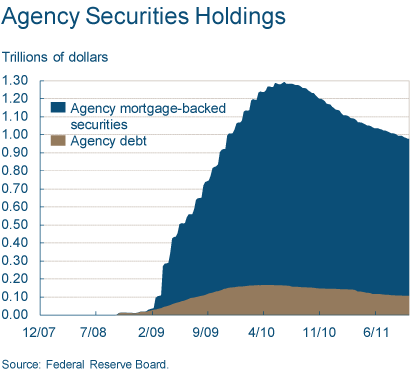
Let's start with the Fed's position prior to the September announcement. The balance of agency securities held by the Fed had been declining steadily since the end of March 2010, when the first round of large-scale asset purchases was being completed. After peaking at nearly $1.3 trillion, the amount of agency security holdings now stands just below $1 trillion.
The total amount of reinvestment purchases that will be made will depend on expected rates of prepayment and principal payments, but it is predicted that somewhere between $200 billion and $300 billion will be purchased through 2012. Initially, approximately $10 billion of purchases were made in the first few weeks of the program, with another $22 billion expected to be reinvested through the middle of November. The effect of the policy will keep the Fed's portfolio of agency securities at nearly $1 trillion.
The guidelines for these purchases are very similar to those established during the initial purchasing program. Securities will be limited to those that are guaranteed by Fannie Mae, Freddie Mac, or Ginnie Mae, and they will largely be concentrated in newly issued agency MBS.
Even though the maturity extension program received the lion's share of the attention following the September FOMC meeting, at least part of the downward spike in mortgage-related yields can likely be attributed to the MBS reinvestment program. The higher demand for agency MBS created by the Fed re-entering the market should raise the value of these packaged securities, lowering the yields. Those effects were seen immediately on MBS yields for both Ginnie Mae and Fannie Mae, whose 30-year current coupon bond yields each fell roughly 50 basis points following the FOMC announcement.
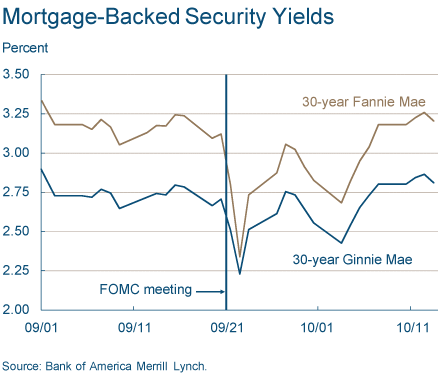
Alternatively, one can examine the impact of the policy change in the prices of MBS. The 30-year current coupon MBS prices from Ginnie and Fannie rose sharply on September 21. The indexed prices for Ginnie Mae and Fannie Mae rose at least 5 index points each, led by a 12-point gain in Fannie Mae's prices. The higher coupon prices tend to increase the value of portfolios holding such long-term securities.
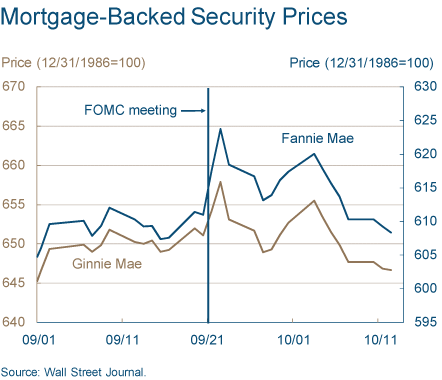
Since the securities being purchased are a packaged group of mortgages, another intended effect of this program will be to lower retail mortgage interest rates relative to what they would have been in the absence of the policy action. This result was observed after the September FOMC meeting, as the 30-year fixed mortgage rate fell to 4.15 percent. Smaller declines were also realized in the 15-year fixed mortgage rate. Combined with the lower yields on mortgage securities, the cumulative result should be a more accommodative mortgage market.
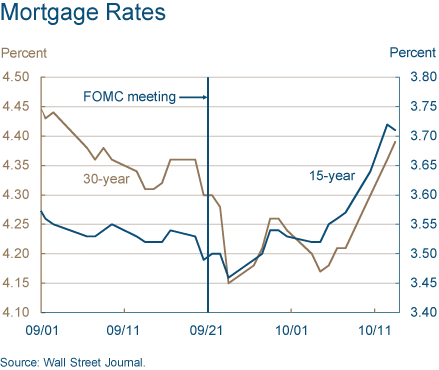
In the weeks following the announcement, the effects have dissipated noticeably. While some may be quick to judge the program as ineffective, the matter is not that clear cut. It could also be argued that the effect of the policy actions on mortgage rates have been obscured by the effect of other economic developments after the September FOMC meeting. For example, the employment report for October beat market expectations, as did retail sales and the ISM manufacturing survey. This improvement in economic conditions had the effect of generally raising the level of interest rates, offsetting the initial movements created by the Fed's announcement. Similarly, the negative news related to the Franco-Belgian bank Dexia had dampening effects on overall interest rates, including MBS bond yields.
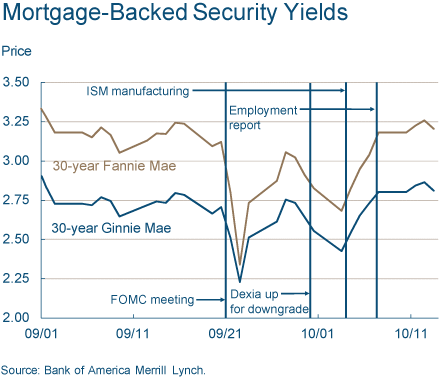
The volatile nature of these types of financial markets makes a simple study of yields and prices an incomplete exercise. However, the immediate effect of the FOMC statement shows that the policy did influence markets and that the policy is likely to influence the expectations of market participants in the future.

